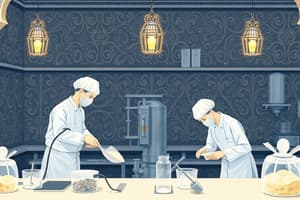Podcast
Questions and Answers
When should food contact surfaces be cleaned and sanitized?
When should food contact surfaces be cleaned and sanitized?
- Only once a day
- Never, only during deep cleaning
- Only when visibly dirty
- After every use (correct)
How should a three compartment sink be prepared for dishwashing?
How should a three compartment sink be prepared for dishwashing?
Clean and sanitized sinks and drainboards, scrape, rinse, or pre-soak items before washing, wash in detergent.
What are the steps that should be taken when cleaning and sanitizing items in a three compartment sink?
What are the steps that should be taken when cleaning and sanitizing items in a three compartment sink?
Wash, rinse, sanitize, and air dry items.
How should clean and sanitized tableware, utensils, and equipment be stored?
How should clean and sanitized tableware, utensils, and equipment be stored?
What factors affect the effects of a sanitizing solution?
What factors affect the effects of a sanitizing solution?
What is required for measuring the sanitizing rinse temperature in a high-temperature dishwashing machine?
What is required for measuring the sanitizing rinse temperature in a high-temperature dishwashing machine?
What is an acceptable sanitizing method and contact time for a food contact surface?
What is an acceptable sanitizing method and contact time for a food contact surface?
If a food-contact surface is in constant use, how often should it be cleaned and sanitized?
If a food-contact surface is in constant use, how often should it be cleaned and sanitized?
What must food do to ensure the sanitizing solution for use on food contact surfaces has been made correctly?
What must food do to ensure the sanitizing solution for use on food contact surfaces has been made correctly?
When washing dishes in a three compartment sink, what is the first thing that you should do?
When washing dishes in a three compartment sink, what is the first thing that you should do?
What feature is the most important for a chemical storage area?
What feature is the most important for a chemical storage area?
How should flatware and utensils that have been cleaned and sanitized be stored?
How should flatware and utensils that have been cleaned and sanitized be stored?
What is the correct way to clean and sanitize a prep table?
What is the correct way to clean and sanitize a prep table?
If you pour cleaner from its original container into a smaller container, what else do you need to do?
If you pour cleaner from its original container into a smaller container, what else do you need to do?
What information should a master cleaning schedule contain?
What information should a master cleaning schedule contain?
Flashcards are hidden until you start studying
Study Notes
Food Contact Surfaces
- Clean and sanitize after every use and between different types of food.
- Required when switching from raw TCS (Time/Temperature Control for Safety) foods or if tasks are interrupted.
Three Compartment Sink Preparation
- Ensure sinks and drainboards are clean and sanitized.
- Pre-scrape, rinse, or soak items before washing.
- Use detergent for washing.
Cleaning and Sanitizing Steps
- Follow the sequence: wash, rinse, sanitize, and air dry items.
Storage of Clean Items
- Store tableware, utensils, and equipment at least 6 inches off the floor.
- Before storing, clean and sanitize drawers.
- Glasses and cups should be stored upside down.
- Keep items covered until use.
Factors Affecting Sanitizing Solutions
- Concentration, water temperature, contact time, water hardness, and pH impact effectiveness.
High-Temperature Dishwashing
- Use a maximum registering thermometer to measure the sanitizing rinse temperature.
Acceptable Sanitizing Method
- Soak food contact surfaces in a chlorine solution for at least 7 seconds.
Cleaning Frequency for Constant Use Surfaces
- Clean and sanitize every 4 hours if the surface is in constant use.
Testing Sanitizing Solution
- Always test the solution with a sanitizer kit to ensure proper concentration.
Initial Steps for Dishwashing
- Start by cleaning and sanitizing the sink and drainboards before washing dishes.
Chemical Storage Area
- Good lighting is essential to ensure safety in the chemical storage area.
Storing Clean Flatware and Utensils
- Store with handles facing up to maintain cleanliness and avoid contamination.
Cleaning and Sanitizing a Prep Table
- Remove all food from the surface, then wash, rinse, sanitize, and allow to air dry.
Labeling Cleaners
- Containers transferred from original to secondary containers must be labeled with contents.
Master Cleaning Schedule
- Should include details on what needs to be cleaned, the date cleaned, who performed the cleaning, and the method used.
Studying That Suits You
Use AI to generate personalized quizzes and flashcards to suit your learning preferences.




